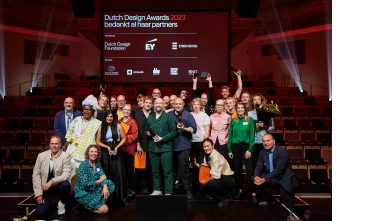While the boundaries between disciplines have increasingly blurred in recent years, the expert jury has assessed more projects this year than ever before that would not have been out of place in other categories. This raises the question of whether design can still be categorised in the same way. Among the entries, crossovers make up the majority of the projects. When choosing the eight winners, creatorship, research and collaboration were rewarded.
 1
1
The quality of research projects was remarkably high. Thorough, systematic, and with good, interdisciplinary teams. There was intensive collaboration with ecologists, biologists, economists, physicians and other scientists, journalists, artists, knowledge and social institutions. This generated interaction on a wider and more diverse number of topics. Projects that question systems – often age-old and complex – whereby ecology, polyphony and economy are the hot topics.
Connecting perspectives and putting yourself in someone else’s shoes are starting points for many of the projects. Social design receives the attention it so rightly deserves as a mature design discipline and is increasingly being used by governments and companies in strategic and relevant places. Designers ask us not only to empathise with other people, other genders or communities, but also with other beings – natural and virtual. These developments lead to serious and valuable conversations about the design profession, in which quality is mainly measured by the meaning of the design. This can be for substantive and aesthetic reasons, with the best projects succeeding in both and adding value to cities, communities and landscapes.
Pleasure
The focus is less on products and more on interaction and movement. The nominees show that this can be done in an uncompromising yet playful way. A pleasure in designing is evident, which brings relief and provides a counterbalance to feeling powerless or overwhelmed. Supposed contradictions are thus refuted: the decorative can be extremely meaningful and simplicity is the ideal outcome of complex processes. Fashion does not necessarily have to be clothing and communication can take many forms.
The art of weaving
Craftsmanship and technology flow together in many projects, and are therefore no longer opposites, but rather complement each other. Textile remains a hot topic. Old techniques and qualities are rediscovered, not for reasons of nostalgia, but often from a sustainability perspective. In order to achieve scalability, traditional crafts are being implemented into current industries in new ways. The applications are tangible, pragmatic and accessible in many projects.
AI has already become interwoven in today’s world. The modest number of distinct entries in this field perhaps illustrates how rapidly this technology has developed, but also highlights the search for meaning or value in it and how we relate to it. We are already researching, testing and working with it, but the truly intelligent art of weaving it into projects is still to come.
Universal
In a less bombastic way and with a rather more modest approach to tackling issues, it can be seen that designers recognise and explore the limits of the problem-solving capabilities of design as a discipline. No big promises that are difficult or impossible to fulfil, but smaller-scale interventions that investigate how design can make a valuable contribution. ‘The more personal, the more universal’ is a motto that is clearly gaining ground in the design field. Many designers use their own history or background as a starting point, with autodidacts being given and taking more space than ever to come forward. Many of the nominated projects can be interpreted as an invitation to step into the designer’s story, to learn about perspectives and worlds that enrich society. Here too we see a lot of collaboration between different disciplines and communities.